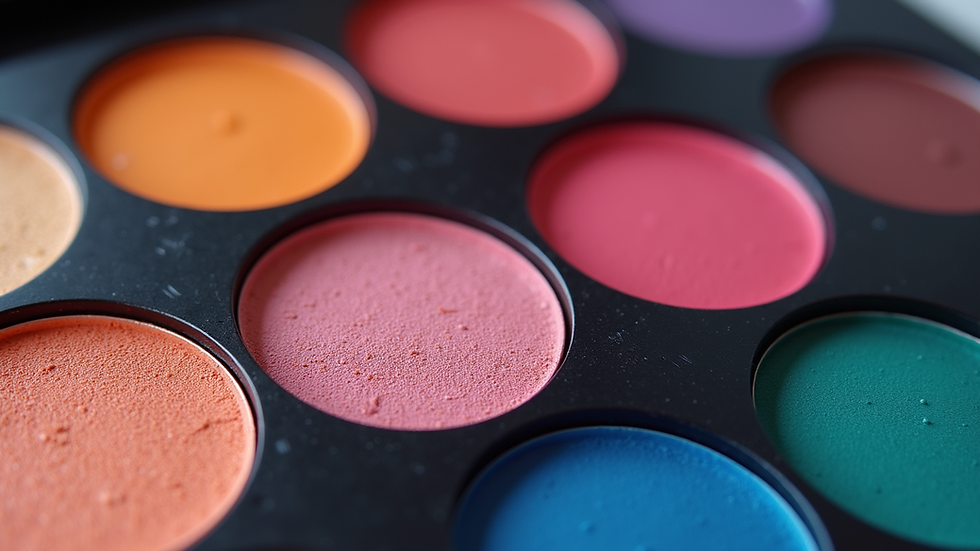Unlocking the Secrets to Flawless Eyeshadow Application Techniques
- Just Beautiful PM
- Jul 18
- 4 min read
Eyeshadow application can truly elevate your makeup look. The right combination of colors, textures, and techniques can transform your eyes from ordinary to extraordinary. Yet, mastering eyeshadow can feel challenging due to the wide array of products available today. Whether you’re just starting out or want to refine your skills, this guide will help you discover the keys to flawless eyeshadow application.
Understanding Eyeshadow Types
Before jumping into application techniques, it’s helpful to know about the different types of eyeshadows. Generally, they fall into three categories:
Powder Eyeshadows: The most common type, available in matte, shimmer, and satin finishes. A great quality powder eyeshadow can range from around $5 to upwards of $50. They are versatile and can be layered for bolder looks.
Cream Eyeshadows: These provide vibrant color and are typically easier to blend. They are excellent for both standalone looks and as a base for powder shadows. Cream eyeshadows can be found in various price ranges, usually between $6 and $40.
Liquid Eyeshadows: Known for their shiny finish and long-lasting wear, liquid shadows can be applied with a wand or brush. Their prices can vary, generally falling between $10 and $30.
Understanding these types allows you to select the best product for your desired effect, ensuring your application is beautiful and long-lasting.
Essential Tools for Application
Using the right tools is vital for successful eyeshadow application. Here’s a list of must-have tools to achieve that perfect look:
Eyeshadow Brushes: A few quality brushes are key, including:
- A flat shader brush for packing on color.
- A blending brush to create seamless transitions.
- A pencil brush for detailing.
Makeup Sponge: A damp makeup sponge works wonders for blending cream or liquid eyeshadows, leading to a smoother finish.
Eye Primer: Applying an eye primer before your eyeshadow can enhance color and longevity. Studies show that 90% of users notice better color intensity and wear throughout the day when using a primer.
Investing in these tools can significantly improve your eyeshadow application results.
The Application Techniques
Step 1: Prep Your Eyelids
Always start with clean, dry eyelids. Apply an eye primer to create a smooth surface for your eyeshadow. This step prevents creasing and ensures that colors remain vibrant throughout the day.
Step 2: Choose Your Colors Wisely
Think about color harmony when selecting shades. Using the color wheel can be helpful here. Complementary colors (those across from each other on the wheel, like blue and orange) enhance each other, while analogous colors (those next to each other, like blue, teal, and green) create a seamless look.
Step 3: Apply the Base Shadow
Select a neutral shadow that matches your skin tone for your base. Applying this all over your eyelid evens out the color, setting the stage for darker shades to come.
Step 4: Define the Crease
Using a fluffy blending brush, apply a mid-tone shade to your crease. This creates depth in your eyes. Blend well to avoid harsh lines that can make your eyes look smaller or more tired.
Step 5: Accent the Lid
For your eyelid, opt for a bolder color. With a flat shader brush, press the eyeshadow onto your lid, focusing on the center. For even more intensity, wet your brush before applying. This technique often makes colors appear brighter and more vivid.

Step 6: Line the Eyes
Adding definition to your eyes can alter their shape. Use a dark eyeshadow or eyeliner that complements your eyeshadow. For a softer effect, consider smudging some eyeshadow along your lash line.
Step 7: Highlight the Brow Bone and Inner Corner
To brighten the area around your eyes, apply a light, shimmery shade to your brow bone and the inner corners. This lift can make your eyes appear fresher and more awake.
Step 8: Blend, Blend, Blend
The secret to flawless eyeshadow is thorough blending. Use a clean, fluffy brush to soften the edges of all shadow applications. Good blending takes time but makes a huge difference in the final look.
Common Mistakes to Avoid
Even experienced makeup lovers can make mistakes. Here’s a quick checklist of what to avoid:
Skipping Primer: Not using primer can lead to creasing and fading.
Wrong Brush Choice: Each eyeshadow brush has a specific purpose. Using the incorrect one can disrupt application.
Overloading on Product: Applying too much product can lead to fallout. Start with a light hand; you can always add more.
Neglecting to Blend: Failing to blend shadows well can result in harsh lines, ruining the overall effect.
By being aware of these errors, you can enhance your application skills and enjoy more flattering results.
Final Thoughts
Achieving flawless eyeshadow application is within your reach. With the right tools and techniques, and a bit of practice, anyone can master this skill. Knowing the differences between types of eyeshadow and how to effectively use them empowers you to create beautiful eye looks for any occasion.
Embrace your creativity and don’t shy away from experimenting with colors and techniques. As with any skill, regular practice will lead to improvement. With these tips, you are ready to unlock the full potential of your eyeshadow skills. Enjoy exploring new palettes and techniques!





Comments